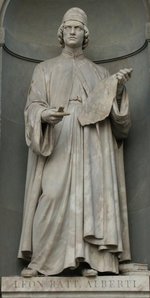Leone Battista Alberti
|
|
Alberti was born in Genoa as an illegitimate son of a family of Florentine merchants. He was educated in law at the University of Bologna. Alberti embarked on a tour of Europe in his mid-twenties. His career in law was curtailed by an illness which induced a partial loss of memory; Alberti then turned his abilities to science and art.
He died in Rome.
| Contents |
Contributions
Alberti made a variety of contributions to several fields:
- In art, He is best known for his treatise De pictura (On painting) (1435) which contained the first scientific study of perspective. An Italian translation of De pictura (Della pittura) was published the year following the Latin version and was dedicated to Filippo Brunelleschi. He also wrote works on sculpture, De Statua.
- He was so skilled in Latin verse that a comedy he wrote in his twentieth year, entitled Philodoxius, would later deceive the younger Aldus Manutius, who edited and published it as the genuine work of Lepidus.
- He has been credited with being the actual author of the Hypnerotomachia Poliphili, a strange fantasy novel, whose typographic qualities and illustrations have made it legendary as one of the most beautiful books ever printed.
- In music, he was reputed one of the first organists of the age. He held the appointment of canon in the metropolitan church of Florence, and thus had leisure to devote himself to his favourite art.
- In architecture he is generally regarded as one of the most devoted to restoring the formal language of classical architecture. At Rome he was employed by Pope Nicholas V in the restoration of the papal palace and of the restoration of the Roman aqueduct of Acqua Vergine, which debouched into a simple basin designed by Alberti, which was swept away later by the Baroque Trevi Fountain. At Mantua he designed the church of Sant'Andrea, and at Rimini the celebrated church of San Francesco. On a commission from the Rucellai family he designed the principal facade of the church of Santa Maria Novella in Florence, as well as the family palace in the Via della Scala, now known as the Palazzo Strozzi. He wrote an influential work on architecture, De Re Aedificatoria, which had been translated into Italian, French, Spanish and English by the 18th century. The most accurate English translation was by Giacomo Leoni in the early 18th century. In it he proposed new methods of fortification which became the standard defense for towns in the age of gunpowder, and dominated siege planning for hundreds of years.
- Alberti was an accomplished cryptographer by the standard of his day, and invented both polyalphabetic ciphers and machine-assisted encryption using his cipher disk. The polyalphabetic cipher was, at least in principle, for it was not properly used for several hundred years, the most significant advance in cryptography since before Julius Caesar's time. Cryptography historian David Kahn titles him the "Father of Western Cryptography", pointing to three significant advances in the field which can be attributed to Alberti: "the earliest Western exposition of cryptanalysis, the invention of polyalphabetic substitution, and the invention of enciphered code" (The Codebreakers, 1967).
- According to some sources, Alberti was capable of standing with his feet together, and springing over a man's head. "We have kept for the last a man who defies classification, and can best be understood as the embodied synthesis of his time. Leon Battista Alberti... was born in Venice of a Florentine exile... [returned to Florence]... and fell in love with its art, its music, its literary and philosophical coteries. Florence responded by hailing him as almost a monstrously perfect man. He was handsome and strong; excelled in all bodily exercises; could, with feet tied, leap over a standing man; could in the great cathedral, throw a coin far up to ring against the vault; amused himself by taming wild horses and climbing mountains. He was a good singer, an eminent organist, a charming conversationalist, an eloquent orator, a man of alert but sober intelligence, a gentleman of refinement and courtesy... Like Leonardo half a century later, Alberti was a master, or at least a skilled practitioner, in a dozen fields-- mathematics, mechanics, architecture, sculpture, painting, music, poetry, drama, philosophy, civil and canon law..."
- From The Renaissance by Will Durant, pp. 107-108.
- He was also interested in the drawing of maps and worked with the astronomer and cartographer Paolo Toscanelli.
Trivia
He is the Renaissance man referenced in the title of the film Renaissance Man.
See also
External links
- Momus, Latin text and English translation, 2003 ISBN 0-674-00754-9
- Online resources for Alberti's buildings
- S. Andrea, Mantua, Italy (http://www.greatbuildings.com/buildings/S._Andrea.html)
- Sta. Maria Novella, Florence, Italy (http://www.greatbuildings.com/buildings/S._Andrea.html)

